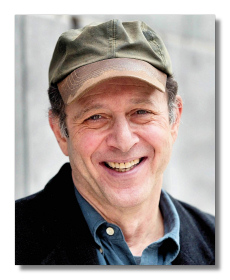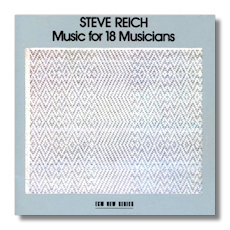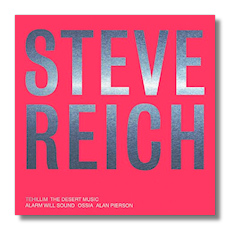
The Internet's Premier Classical Music Source
Related Links
-
Find CDs & Downloads
Amazon - UK - Germany - Canada - France - Japan
ArkivMusic - CD Universe
Find DVDs & Blu-ray
Amazon - UK - Germany - Canada - France - Japan
ArkivMusic-Video Universe
Find Scores & Sheet Music
Sheet Music Plus -
- Steve Reich's Home Page
- Steve Reich: The Composer and his Critics
- Steve Reich
by John Kannenberg
Recommended Links
Site News
Steve Reich

(b. 1936)
Steve Reich (b. October 3, 1936 in New York City), as an early pioneer in tape music and American minimalism, has established himself as one of the foremost composers of our time. Following studies in philosophy at Cornell University (1953-7), Reich turned to composition, first with Vincent Persichetti at Julliard (1958-61), then with Luciano Berio and Darius Milhaud at Mills College (1962-3).
His music is characterized by a strong, steady pulse and strictly diatonic and tonal harmonies. He is typically grouped together with other "first generation" minimalist composers such as Philip Glass and La Monte Young, and more recently with younger composers such as John Adams. The music is deeply "American" in its roots, with an unrelenting pulse and short, repeating melodic figures often compared to rock-and-roll and be-bop. However, like other minimalist composers, Reich's music is also largely influenced by extra-European forms and techniques, generally viewed as a response to the largely academic, elitist climate of new music in the 1950's and 60's.
Reich's early works were created in the early 1960's at the San Francisco Tape Music Center. These tape pieces, such as "It's Gonna Rain" (1965) and "Come Out" (1966), are the earliest examples of "phasing," one of Reich's most used and most well known techniques. In this process, two tape loops are set into motion at two slightly different speeds, so that the tapes begin in unison and slowly shift "out of phase," creating a new set of harmonies and rhythms. This process was later incorporated into several pieces for traditional acoustic instruments (or instruments and tape), such as in "Piano Phase" (1967) and "Violin Phase" (1967). In addition to the initial process of phasing, Reich also introduces into "Violin Phase" the notion of "found" or "resulting" patterns (new melodic figures created from the overlapping voices of the original "theme").
This technique was further explored in the largely popular and influential "Drumming" of 1971. In 1970, Reich set out on an intensive study of Ghanaian drumming that, either directly or indirectly, led to many of the procedures used not only in "Drumming" but also throughout the remainder of his career. This piece is an enormous, hour-long elaboration of a single rhythmic cell, developed and re-orchestrated through four distinct sections. The piece begins with a slow, additive process of introducing the initial rhythmic pattern. Through phasing procedures and further "build-up and reduction," new melodic and harmonic patterns are created – these are brought to the fore by doublings, first by female voice, then by whistling, and finally by piccolo.
Reich's later music is characterized by a considerably faster harmonic rate of change, and by a more diverse (though still strictly diatonic) harmonic language. In the mid to late 1970's, a series of commissions from ensembles other than his own (up until this point, Reich's ensemble was the sole performing group for his music) led to several non-percussion works; "Music for 18 Musicians" (1976), "Music for a Large Ensemble" (1978) and "Octet" (1979) all came in this period.
Recently, Reich has returned to the ideas first seen in "Violin Phase" in a series of pieces for solo instruments and tape. "Vermont Counterpoint," for flute, "New York Counterpoint," for clarinet, and "Electric Counterpoint" for electric guitar, build upon the original processes of the early phasing music. The complexity, however, is far deeper than the early phasing pieces: In Vermont Counterpoint, for example, a total of 10 layers are prerecorded, with the final 11th flute layer played live.
Reich has also recently returned to the voice, as in "Tehillim" (1981), a setting of Psalm texts in Hebrew, "Different Trains" (1988) for string quartet and tape, and in Reich's hugely successful venture into the theater, "The Cave" (1990-3). Each of these works explores the pitch of taped and sequenced voices, and then uses those pitches as melodic material in the accompanying instrumental ensemble.
Reich's combination of repetition and process creates a music full of vitality and energy. His strict, tonal melodic style has brought Reich much critical acclaim, even in a general public that often is distrustful of "new music." As such, Reich has, in many ways, led a charge toward establishing the accessible and almost "anti-academic" diatribe of the newest developments in contemporary music. ~ Aaron M. Cassidy
Recommended Recordings
Music For 18 Musicians
- "Music for 18 Musicians"/ECM 1129
-
Steve Reich and Musicians
- "Music for 18 Musicians"/Nonesuch 79448
-
Steve Reich and Musicians
- "Music for 18 Musicians"/Innova Hybrid Multichannel SACD 1129
-
Bill Ryan/Grand Valley State University New Music Ensemble
- "Music for 18 Musicians"/RCA Victor Red Seal 68672
-
Ensemble Modern
Desert Music
- "The Desert Music"/Elektra Nonesuch 79101-2
-
Michael Tilson Thomas/Steve Reich and Musicians, Brooklyn Philharmonic Orchestra & Chorus
- "The Desert Music" (Chamber Version); Tehillim/Cantaloupe 21009
-
Alan Pierson/Alarm Will Sound and Ossia
Additional Recommended Listening:
- Early Music ("It's gonna rain," "Come out," "Piano Phase," "Clapping Music")/Elektra Nonesuch 79169-2
- Steve Reich and Musicians
"Drumming"/Elektra Nonesuch 79170-2
- Steve Reich and Musicians
"Music for a Large Ensemble," "Octet," "Violin Phase"/ECM 168
- Steve Reich and Musicians
- "Tehillim" & "Three Movements"/Elektra Nonesuch 79295-2
- Steve Reich, Ensemble
"Different Trains" & "Electric Counterpoint"/Elektra Nonesuch 79176-2
- Kronos Quartet, Pat Metheny (guitar)
- "New York Counterpoint" (plus various Clarinet Music by American composers)/Clarinet Classics 0009
- Roger Heaton (clarinet)
- "Sextet" & "Six Marimbas"/Elektra Nonesuch 79138
- Steve Reich and Musicians with members of Nexus and the Manhattan Marimba Quartet
The Cave (text by Beryl Karot)/Elektra Nonesuch
- Steve Reich and Musicians















